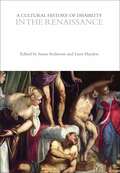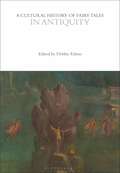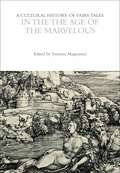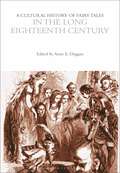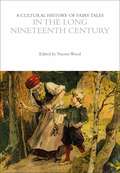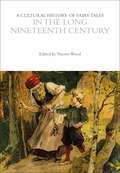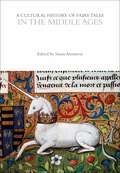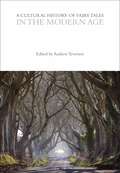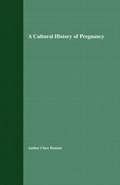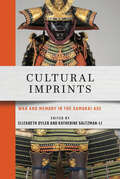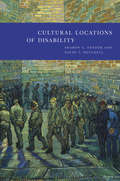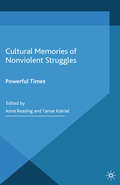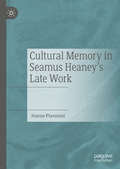- Table View
- List View
A Cultural History of Disability in the Renaissance (The Cultural Histories Series)
by Susan Anderson and Liam HaydonIn Renaissance humanism, difference was understood through a variety of paradigms that rendered particular kinds of bodies and minds disabled. A Cultural History of Disability in the Renaissance, covering the period from 1450 to 1650, explores evidence of the possibilities for disability that existed in the European Renaissance, observable in the literary and medicinal texts, and the family, corporate, and legal records discussed in the chapters of this volume. These chapters provide an interdisciplinary overview of the configurations of bodies, minds and collectives that have left evidence of some of the ways that normativity and its challengers interacted in the Renaissance.An essential resource for researchers, scholars and students of history, literature, culture and education, A Cultural History of Disability in the Renaissance explores such themes and topics as: atypical bodies; mobility impairment; chronic pain and illness; blindness; deafness; speech; learning difficulties; and mental health.
A Cultural History of Early Modern English Cryptography Manuals
by Katherine EllisonDuring and after the English civil wars, between 1640 and 1690, an unprecedented number of manuals teaching cryptography were published, almost all for the general public. While there are many surveys of cryptography, none pay any attention to the volume of manuals that appeared during the seventeenth century, or provide any cultural context for the appearance, design, or significance of the genre during the period. On the contrary, when the period’s cryptography writings are mentioned, they are dismissed as esoteric, impractical, and useless. Yet, as this book demonstrates, seventeenth-century cryptography manuals show us one clear beginning of the capitalization of information. In their pages, intelligence—as private message and as mental ability—becomes a central commodity in the emergence of England’s capitalist media state. Publications boasting the disclosure of secrets had long been popular, particularly for English readers with interests in the occult, but it was during these particular decades of the seventeenth century that cryptography emerged as a permanent bureaucratic function for the English government, a fashionable activity for the stylish English reader, and a respected discipline worthy of its own genre. These manuals established cryptography as a primer for intelligence, a craft able to identify and test particular mental abilities deemed "smart" and useful for England’s financial future. Through close readings of five specific primary texts that have been ignored not only in cryptography scholarship but also in early modern literary, scientific, and historical studies, this book allows us to see one origin of disciplinary division in the popular imagination and in the university, when particular broad fields—the sciences, the mechanical arts, and the liberal arts—came to be viewed as more or less profitable.
A Cultural History of Early Modern English Cryptography Manuals
by Katherine EllisonDuring and after the English civil wars, between 1640 and 1690, an unprecedented number of manuals teaching cryptography were published, almost all for the general public. While there are many surveys of cryptography, none pay any attention to the volume of manuals that appeared during the seventeenth century, or provide any cultural context for the appearance, design, or significance of the genre during the period. On the contrary, when the period’s cryptography writings are mentioned, they are dismissed as esoteric, impractical, and useless. Yet, as this book demonstrates, seventeenth-century cryptography manuals show us one clear beginning of the capitalization of information. In their pages, intelligence—as private message and as mental ability—becomes a central commodity in the emergence of England’s capitalist media state. Publications boasting the disclosure of secrets had long been popular, particularly for English readers with interests in the occult, but it was during these particular decades of the seventeenth century that cryptography emerged as a permanent bureaucratic function for the English government, a fashionable activity for the stylish English reader, and a respected discipline worthy of its own genre. These manuals established cryptography as a primer for intelligence, a craft able to identify and test particular mental abilities deemed "smart" and useful for England’s financial future. Through close readings of five specific primary texts that have been ignored not only in cryptography scholarship but also in early modern literary, scientific, and historical studies, this book allows us to see one origin of disciplinary division in the popular imagination and in the university, when particular broad fields—the sciences, the mechanical arts, and the liberal arts—came to be viewed as more or less profitable.
A Cultural History of Fairy Tales in Antiquity (The Cultural Histories Series)
How have fairy tales from around the world changed over the centuries? What do they tell us about different cultures and societies? Spanning chronologically from the third millennium BCE through to the seventh century CE and beyond, and geographically from the Mediterranean to the Near East and Asia, this book explores the earliest known evidence of familiar folk tales and fairy tales in the ancient world.Drawing on sources including the Rig Veda, the Epic of Gilgamesh, the Old Testament, the Westcar Papyrus, and the Odyssey, this volume ranges from epic poetry to drama, to fables and proverbs, and from ancient histories to novels.Scholars in Classics, Anthropology, Folklore, and Asian Studies examine the dissemination, adaptation, and cross-cultural interactions of early forms of folk tales, providing new insights into how they functioned and circulated across different societies.An essential resource for scholars and students of ancient literature, history, and cultural studies, this book explores topics including: forms of the marvelous, gender and sexuality, monsters and the monstrous, the significance of spaces, socialization and moral messaging, and the uses and abuses of power.
A Cultural History of Fairy Tales in the Age of the Marvelous (The Cultural Histories Series)
by Suzanne MagnaniniHow have fairy tales from around the world changed over the centuries? What do they tell us about different cultures and societies?Drawing on the contributions of scholars working on Italian, French, English, Ottoman Turkish, and Japanese tale traditions, this book underscores the striking mobility and malleability of fairy tales written in the years 1450 to 1650. The essays examine how early modern scientific theories, debates on the efficacy of witchcraft, conceptions of race and gender, religious beliefs, the aesthetics of landscape, and censorial practices all shaped the representations of magic and marvels in the tales of this period.Tracing the fairy tale's swift movement across linguistic and geographic borders, through verse and prose versions, from the printed page to the early modern stage, this volume demonstrates the ways in which these fantastic literary texts explored the ideological borders constructed by different societies.An essential resource for researchers, scholars and students of literature, history and cultural studies, contributors explore themes including: forms of the marvelous, adaption, gender and sexuality, humans and non-humans, monsters and the monstrous, space, socialization, and power.A Cultural History of Fairy Tales (6-volume set)A Cultural History of Fairy Tales in Antiquity is also available as a part of a 6-volume set, A Cultural History of Fairy Tales, tracing fairy tales from antiquity to the present day, available in print, or within a fully-searchable digital library accessible through institutions by annual subscription or on perpetual access (see www.bloomsburyculturalhistory.com). Individual volumes for academics and researchers interested in specific historical periods are also available digitally via www.bloomsburycollections.com.
A Cultural History of Fairy Tales in the Long Eighteenth Century (The Cultural Histories Series)
by Anne E. DugganHow have fairy tales from around the world changed over the centuries? What do they tell us about different cultures and societies?This volume traces the evolution of the genre over the period known as the long eighteenth century. It explores key developments including: the French fairy tale vogue of the 1690s, dominated by women authors including Marie-Catherine d'Aulnoy and Marie-Jeanne Lhéritier, the fashion of the oriental tale in the early eighteenth century, launched by Antoine Galland's seminal translation of The Thousand and One Nights from Arabic into French, and the birth of European children's literature in the second half of the eighteenth century. Drawing together contributions from an international range of scholars in history, literature and cultural studies, this volume examines the intersections between diverse national tale traditions through different critical perspectives, producing an authoritative transnational history of the genre. An essential resource for researchers, scholars and students of literature, history and cultural studies, this book explores such themes and topics as: forms of the marvelous, adaptation, gender and sexuality, humans and non-humans, monsters and the monstrous, spaces, socialization, and power.A Cultural History of Fairy Tales (6-volume set)A Cultural History of Fairy Tales in Antiquity is also available as a part of a 6-volume set, A Cultural History of Fairy Tales, tracing fairy tales from antiquity to the present day, available in print, or within a fully-searchable digital library accessible through institutions by annual subscription or on perpetual access (see www.bloomsburyculturalhistory.com). Individual volumes for academics and researchers interested in specific historical periods are also available digitally via www.bloomsburycollections.com.
A Cultural History of Fairy Tales in the Long Eighteenth Century (The Cultural Histories Series)
How have fairy tales from around the world changed over the centuries? What do they tell us about different cultures and societies?This volume traces the evolution of the genre over the period known as the long eighteenth century. It explores key developments including: the French fairy tale vogue of the 1690s, dominated by women authors including Marie-Catherine d'Aulnoy and Marie-Jeanne Lhéritier, the fashion of the oriental tale in the early eighteenth century, launched by Antoine Galland's seminal translation of The Thousand and One Nights from Arabic into French, and the birth of European children's literature in the second half of the eighteenth century. Drawing together contributions from an international range of scholars in history, literature and cultural studies, this volume examines the intersections between diverse national tale traditions through different critical perspectives, producing an authoritative transnational history of the genre. An essential resource for researchers, scholars and students of literature, history and cultural studies, this book explores such themes and topics as: forms of the marvelous, adaptation, gender and sexuality, humans and non-humans, monsters and the monstrous, spaces, socialization, and power.A Cultural History of Fairy Tales (6-volume set)A Cultural History of Fairy Tales in Antiquity is also available as a part of a 6-volume set, A Cultural History of Fairy Tales, tracing fairy tales from antiquity to the present day, available in print, or within a fully-searchable digital library accessible through institutions by annual subscription or on perpetual access (see www.bloomsburyculturalhistory.com). Individual volumes for academics and researchers interested in specific historical periods are also available digitally via www.bloomsburycollections.com.
A Cultural History of Fairy Tales in the Long Nineteenth Century (The Cultural Histories Series)
by Naomi J. WoodHow have fairy tales from around the world changed over the centuries? What do they tell us about different cultures and societies?This volume explores the period when the European fairy tales conquered the world and shaped the global imagination in its own image. Examining how collectors, children's writers, poets, and artists seized the form to challenge convention and normative ideas, this book explores the fantastic imagination that belies the nineteenth century's materialist and pedestrian reputation. Looking at writers including E.T.A Hoffman, the Brothers Grim, S.T. Coleridge, Walter Scott, Oscar Wilde, Christina Rosetti, George MacDonald, and E. Nesbit, the volume shows how fairy tales touched every aspect of nineteenth century life and thought. It provides new insights into themes including: forms of the marvelous, adaptation, gender and sexuality, humans and non-humans, monsters and the monstrous, spaces, socialization, and power. With contributions from international scholars across disciplines, this volume is an essential resource for researchers, scholars and students of literature, history, and cultural studies.A Cultural History of Fairy Tales (6-volume set)A Cultural History of Fairy Tales in Antiquity is also available as a part of a 6-volume set, A Cultural History of Fairy Tales, tracing fairy tales from antiquity to the present day, available in print, or within a fully-searchable digital library accessible through institutions by annual subscription or on perpetual access (see www.bloomsburyculturalhistory.com). Individual volumes for academics and researchers interested in specific historical periods are also available digitally via www.bloomsburycollections.com.
A Cultural History of Fairy Tales in the Long Nineteenth Century (The Cultural Histories Series)
How have fairy tales from around the world changed over the centuries? What do they tell us about different cultures and societies?This volume explores the period when the European fairy tales conquered the world and shaped the global imagination in its own image. Examining how collectors, children's writers, poets, and artists seized the form to challenge convention and normative ideas, this book explores the fantastic imagination that belies the nineteenth century's materialist and pedestrian reputation. Looking at writers including E.T.A Hoffman, the Brothers Grim, S.T. Coleridge, Walter Scott, Oscar Wilde, Christina Rosetti, George MacDonald, and E. Nesbit, the volume shows how fairy tales touched every aspect of nineteenth century life and thought. It provides new insights into themes including: forms of the marvelous, adaptation, gender and sexuality, humans and non-humans, monsters and the monstrous, spaces, socialization, and power. With contributions from international scholars across disciplines, this volume is an essential resource for researchers, scholars and students of literature, history, and cultural studies.A Cultural History of Fairy Tales (6-volume set)A Cultural History of Fairy Tales in Antiquity is also available as a part of a 6-volume set, A Cultural History of Fairy Tales, tracing fairy tales from antiquity to the present day, available in print, or within a fully-searchable digital library accessible through institutions by annual subscription or on perpetual access (see www.bloomsburyculturalhistory.com). Individual volumes for academics and researchers interested in specific historical periods are also available digitally via www.bloomsburycollections.com.
A Cultural History of Fairy Tales in the Middle Ages (The Cultural Histories Series)
by Susan AronsteinHow have fairy tales from around the world changed over the centuries? What do they tell us about different cultures and societies? Spanning the years from 900 to 1500 and traversing geographical borders, from England to France and India to China, this book uniquely examines the tales told, translated, adapted and circulated during the period known as the Middle Ages. Scholars in history, literature and cultural studies explore the development of epic tales of heroes and monsters and enchanted romance narratives. Examining how tales evolved and functioned across different societies during the Middle Ages, this book demonstrates how the plots, themes and motifs used in medieval tales influenced later developments in the genre. An essential resource for researchers, scholars and students of literature, history and cultural studies, this volume explores themes including: forms of the marvelous, adaptation, gender and sexuality, humans and non-humans, monsters and the monstrous, spaces, socialization, and power.A Cultural History of Fairy Tales (6-volume set)A Cultural History of Fairy Tales in Antiquity is also available as a part of a 6-volume set, A Cultural History of Fairy Tales, tracing fairy tales from antiquity to the present day, available in print, or within a fully-searchable digital library accessible through institutions by annual subscription or on perpetual access (see www.bloomsburyculturalhistory.com). Individual volumes for academics and researchers interested in specific historical periods are also available digitally via www.bloomsburycollections.com.
A Cultural History of Fairy Tales in the Middle Ages (The Cultural Histories Series)
How have fairy tales from around the world changed over the centuries? What do they tell us about different cultures and societies? Spanning the years from 900 to 1500 and traversing geographical borders, from England to France and India to China, this book uniquely examines the tales told, translated, adapted and circulated during the period known as the Middle Ages. Scholars in history, literature and cultural studies explore the development of epic tales of heroes and monsters and enchanted romance narratives. Examining how tales evolved and functioned across different societies during the Middle Ages, this book demonstrates how the plots, themes and motifs used in medieval tales influenced later developments in the genre. An essential resource for researchers, scholars and students of literature, history and cultural studies, this volume explores themes including: forms of the marvelous, adaptation, gender and sexuality, humans and non-humans, monsters and the monstrous, spaces, socialization, and power.A Cultural History of Fairy Tales (6-volume set)A Cultural History of Fairy Tales in Antiquity is also available as a part of a 6-volume set, A Cultural History of Fairy Tales, tracing fairy tales from antiquity to the present day, available in print, or within a fully-searchable digital library accessible through institutions by annual subscription or on perpetual access (see www.bloomsburyculturalhistory.com). Individual volumes for academics and researchers interested in specific historical periods are also available digitally via www.bloomsburycollections.com.
A Cultural History of Fairy Tales in the Modern Age (The Cultural Histories Series)
by Andrew TeversonHow have fairy tales from around the world changed over the centuries? What do they tell us about different cultures and societies?Drawing together contributions from an international range of scholars in history, literature, and cultural studies, this volume uniquely examines creative applications of fairy tales in the twentieth and twenty-first centuries. It explores how the fairy tale has become a genre that flourishes on film, on TV, and in digital media, as well as in the older technologies of print, performance, and the visual arts. An essential resource for researchers, scholars and students of literature, history, the visual arts and cultural studies, this book explores such themes and topics as: forms of the marvelous, adaptation, gender and sexuality, humans and non-humans, monsters and the monstrous, spaces, socialization, and power.A Cultural History of Fairy Tales (6-volume set)A Cultural History of Fairy Tales in Antiquity is also available as a part of a 6-volume set, A Cultural History of Fairy Tales, tracing fairy tales from antiquity to the present day, available in print, or within a fully-searchable digital library accessible through institutions by annual subscription or on perpetual access (see www.bloomsburyculturalhistory.com). Individual volumes for academics and researchers interested in specific historical periods are also available digitally via www.bloomsburycollections.com.
A Cultural History of Fairy Tales in the Modern Age (The Cultural Histories Series)
How have fairy tales from around the world changed over the centuries? What do they tell us about different cultures and societies?Drawing together contributions from an international range of scholars in history, literature, and cultural studies, this volume uniquely examines creative applications of fairy tales in the twentieth and twenty-first centuries. It explores how the fairy tale has become a genre that flourishes on film, on TV, and in digital media, as well as in the older technologies of print, performance, and the visual arts. An essential resource for researchers, scholars and students of literature, history, the visual arts and cultural studies, this book explores such themes and topics as: forms of the marvelous, adaptation, gender and sexuality, humans and non-humans, monsters and the monstrous, spaces, socialization, and power.A Cultural History of Fairy Tales (6-volume set)A Cultural History of Fairy Tales in Antiquity is also available as a part of a 6-volume set, A Cultural History of Fairy Tales, tracing fairy tales from antiquity to the present day, available in print, or within a fully-searchable digital library accessible through institutions by annual subscription or on perpetual access (see www.bloomsburyculturalhistory.com). Individual volumes for academics and researchers interested in specific historical periods are also available digitally via www.bloomsburycollections.com.
A Cultural History of Pregnancy: Pregnancy, Medicine and Culture, 1750-2000
by C. HansonHanson explores the different ways in which pregnancy has been constructed and interpreted in Britain over the last 250 years. Drawing on a wide range of sources, including obstetric texts, pregnancy advice books, literary texts, popular fiction and visual images, she analyzes changing attitudes to key issues such as the relative rights of mother and foetus and the degree to which medical intervention is acceptable in pregnancy. Hanson also considers the effects of medical and social changes on the subjective experience of pregnancy.
Cultural History of Reading [2 volumes]: [2 volumes]
What is it about some books that makes them timeless? Cultural History of Reading looks at books from their earliest beginnings through the present day, in both the U.S. and regions all over the world. Not only fiction and literature, but religious works, dictionaries, scientific works, and home guides such as Mrs. Beeton's all have had an impact on not only their own time and place, but continue to capture the attention of readers today. Volume 1 examines the history of books in regions throughout the world, identifying both literature and nonfiction that was influenced by cultural events of its time. Volume 2 identifies books from the pre-colonial era to the present day that have had lasting significance in the United States. History students and book lovers alike will enjoy discovering the books that have impacted our world.
Cultural Identity in Hindi Plays: Poetics, Politics, and Theatre in India
by Diana DimitrovaThis book deals with the interface between identity, culture and literature. It aims at studying questions of cultural identity and gender in Hindi plays of the 19th- and 20th- centuries and the interplay of poetics and politics, as revealed in the work of several influential playwrights. The book explores questions related to the ways in which seven representative playwrights imagine India and its identity and the ways, in which this concept is revealed in the "narratives of the nation", its postcolonial contentions and the politics of identity, as revealed in the production of various cultural discourses. The chapters explore various aspects of the ongoing process of constructing and narrating culture, gender, the nation and identity. There has been no monograph on the questions of cultural identity in Hindi drama. This is a pioneering project and a desideratum in the field of Hindi literature, South Asian Studies, and broadly, in the study of theatre of India and of South Asian cultures and literatures.
Cultural Identity in Hindi Plays: Poetics, Politics, and Theatre in India
by Diana DimitrovaThis book deals with the interface between identity, culture and literature. It aims at studying questions of cultural identity and gender in Hindi plays of the 19th- and 20th- centuries and the interplay of poetics and politics, as revealed in the work of several influential playwrights. The book explores questions related to the ways in which seven representative playwrights imagine India and its identity and the ways, in which this concept is revealed in the "narratives of the nation", its postcolonial contentions and the politics of identity, as revealed in the production of various cultural discourses. The chapters explore various aspects of the ongoing process of constructing and narrating culture, gender, the nation and identity. There has been no monograph on the questions of cultural identity in Hindi drama. This is a pioneering project and a desideratum in the field of Hindi literature, South Asian Studies, and broadly, in the study of theatre of India and of South Asian cultures and literatures.
The Cultural Imaginary of Terrorism in Public Discourse, Literature, and Film: Narrating Terror (Routledge Interdisciplinary Perspectives on Literature)
by Michael C. FrankThis study investigates the overlaps between political discourse and literary and cinematic fiction, arguing that both are informed by, and contribute to, the cultural imaginary of terrorism. Whenever mass-mediated acts of terrorism occur, they tend to trigger a proliferation of threat scenarios not only in the realm of literature and film but also in the statements of policymakers, security experts, and journalists. In the process, the discursive boundary between the factual and the speculative can become difficult to discern. To elucidate this phenomenon, this book proposes that terror is a halfway house between the real and the imaginary. For what characterizes terrorism is less the single act of violence than it is the fact that this act is perceived to be the beginning, or part, of a potential series, and that further acts are expected to occur. As turn-of-the-century writers such as Stevenson and Conrad were the first to point out, this gives terror a fantastical dimension, a fact reinforced by the clandestine nature of both terrorist and counter-terrorist operations. Supported by contextual readings of selected texts and films from The Dynamiter and The Secret Agent through late-Victorian science fiction to post-9/11 novels and cinema, this study explores the complex interplay between actual incidents of political violence, the surrounding discourse, and fictional engagement with the issue to show how terrorism becomes an object of fantasy. Drawing on research from a variety of disciplines, The Cultural Imaginary of Terrorism will be a valuable resource for those with interests in the areas of Literature and Film, Terrorism Studies, Peace and Conflict Studies, Trauma Studies, and Cultural Studies.
The Cultural Imaginary of Terrorism in Public Discourse, Literature, and Film: Narrating Terror (Routledge Interdisciplinary Perspectives on Literature)
by Michael C. FrankThis study investigates the overlaps between political discourse and literary and cinematic fiction, arguing that both are informed by, and contribute to, the cultural imaginary of terrorism. Whenever mass-mediated acts of terrorism occur, they tend to trigger a proliferation of threat scenarios not only in the realm of literature and film but also in the statements of policymakers, security experts, and journalists. In the process, the discursive boundary between the factual and the speculative can become difficult to discern. To elucidate this phenomenon, this book proposes that terror is a halfway house between the real and the imaginary. For what characterizes terrorism is less the single act of violence than it is the fact that this act is perceived to be the beginning, or part, of a potential series, and that further acts are expected to occur. As turn-of-the-century writers such as Stevenson and Conrad were the first to point out, this gives terror a fantastical dimension, a fact reinforced by the clandestine nature of both terrorist and counter-terrorist operations. Supported by contextual readings of selected texts and films from The Dynamiter and The Secret Agent through late-Victorian science fiction to post-9/11 novels and cinema, this study explores the complex interplay between actual incidents of political violence, the surrounding discourse, and fictional engagement with the issue to show how terrorism becomes an object of fantasy. Drawing on research from a variety of disciplines, The Cultural Imaginary of Terrorism will be a valuable resource for those with interests in the areas of Literature and Film, Terrorism Studies, Peace and Conflict Studies, Trauma Studies, and Cultural Studies.
Cultural Implications of Biosemiotics (Biosemiotics #15)
by Paul CobleyThis is the first book to consider the major implications for culture of the new science of biosemiotics. The volume is mainly aimed at an audience outside biosemiotics and semiotics, in the humanities and social sciences principally, who will welcome elucidation of the possible benefits to their subject area from a relatively new field. The book is therefore devoted to illuminating the extent to which biosemiotics constitutes an ‘epistemological break’ with ‘modern’ modes of conceptualizing culture. It shows biosemiotics to be a significant departure from those modes of thought that neglect to acknowledge continuity across nature, modes which install culture and the vicissitudes of the polis at the centre of their deliberations. The volume exposes the untenability of the ‘culture/nature’ division, presenting a challenge to the many approaches that can only produce an understanding of culture as a realm autonomous and divorced from nature.
Cultural Imprints: War and Memory in the Samurai Age
by Elizabeth OylerCultural Imprints draws on literary works, artifacts, performing arts, and documents that were created by or about the samurai to examine individual "imprints," traces holding specifically grounded historical meanings that persist through time. The contributors to this interdisciplinary volume assess those imprints for what they can suggest about how thinkers, writers, artists, performers, and samurai themselves viewed warfare and its lingering impact at various points during the "samurai age," the long period from the establishment of the first shogunate in the twelfth century through the fall of the Tokugawa in 1868. The range of methodologies and materials discussed in Cultural Imprints challenges a uniform notion of warrior activity and sensibilities, breaking down an ahistorical, monolithic image of the samurai that developed late in the samurai age and that persists today. Highlighting the memory of warfare and its centrality in the cultural realm, Cultural Imprints demonstrates the warrior's far-reaching, enduring, and varied cultural influence across centuries of Japanese history.Contributors: Monica Bethe, William Fleming, Andrew Goble, Thomas Hare, Luke Roberts, Marimi Tateno, Alison Tokita, Elizabeth Oyler, Katherine Saltzman-Li
Cultural Labour: Conceptualizing the ‘Folk Performance’ in India
by Brahma PrakashFolk performances reflect the life-worlds of a vast section of subaltern communities in India. What is the philosophy that drives these performances, the vision that enables as well as enslaves these communities to present what they feel, think, imagine, and want to see? Can such performances challenge social hierarchies and ensure justice in a caste-ridden society? In Cultural Labour, the author studies bhuiyan puja (land worship), bidesia (theatre of migrant labourers), Reshma-Chuharmal (Dalit ballads), dugola (singing duels) from Bihar, and the songs and performances of Gaddar, who was associated with Jana Natya Mandali, Telangana: he examines various ways in which meanings and behaviour are engendered in communities through rituals, theatre, and enactments. Focusing on various motifs of landscape, materiality, and performance, the author looks at the relationship between culture and labour in its immediate contexts. Based on an extensive ethnography and the author’s own life experience as a member of such a community, the book offers a new conceptual framework to understand the politics and aesthetics of folk performance in the light of contemporary theories of theatre and performance studies.
Cultural Locations of Disability
by David T. Mitchell Sharon L. SnyderIn Cultural Locations of Disability, Sharon L. Snyder and David T. Mitchell trace how disabled people came to be viewed as biologically deviant. The eugenics era pioneered techniques that managed "defectives" through the application of therapies, invasive case histories, and acute surveillance techniques, turning disabled persons into subjects for a readily available research pool. In its pursuit of normalization, eugenics implemented disability regulations that included charity systems, marriage laws, sterilization, institutionalization, and even extermination. Enacted in enclosed disability locations, these practices ultimately resulted in expectations of segregation from the mainstream, leaving today's disability politics to focus on reintegration, visibility, inclusion, and the right of meaningful public participation. Snyder and Mitchell reveal cracks in the social production of human variation as aberrancy. From our modern obsessions with tidiness and cleanliness to our desire to attain perfect bodies, notions of disabilities as examples of human insufficiency proliferate. These disability practices infuse more general modes of social obedience at work today. Consequently, this important study explains how disabled people are instrumental to charting the passage from a disciplinary society to one based upon regulation of the self.
Cultural Memories of Nonviolent Struggles: Powerful Times (Palgrave Macmillan Memory Studies)
by Tamar Katriel Anna ReadingIf societies have only memories of war, of cruelty, of violence, then why are we called humankind? This book marks a new trajectory in Memory Studies by examining cultural memories of nonviolent struggles from ten countries. The book reminds us of the enduring cultural scripts for human agency, solidarity, resilience and human kindness.
Cultural Memory in Seamus Heaney’s Late Work
by Joanne PiavaniniCultural Memory in Seamus Heaney’s Late Work considers the ways that memory functions in Heaney’s poetry. Joanne Piavanini argues that the shaping of collective memory is one of Heaney’s major contributions as a poet. Locating Heaney in a transnational literary sphere, this book argues that his late work isdefined by a type of cosmopolitanism openness: the work moves beyond national identity to explore multiple allegiances and identifications. Moreover, Piavanini demonstrates that memory is a helpful lens to look at Heaney’s late work, in particular, because of the interplay of past, present and future in these works: in the construction of a collective memory of the Troubles; in the use of the elegy to commemorate the passing of important contemporary poets; in his writing on events with transnational significance, such as 9/11; in the slippages between past and present in poems about his family; and through the literary afterlives of texts—specifically, his appropriation of canonical classical texts. Drawing on approaches and concepts from memory studies, Piavanini considers Heaney’s late work to develop an analysis of poetry as a vehicle of memory.
